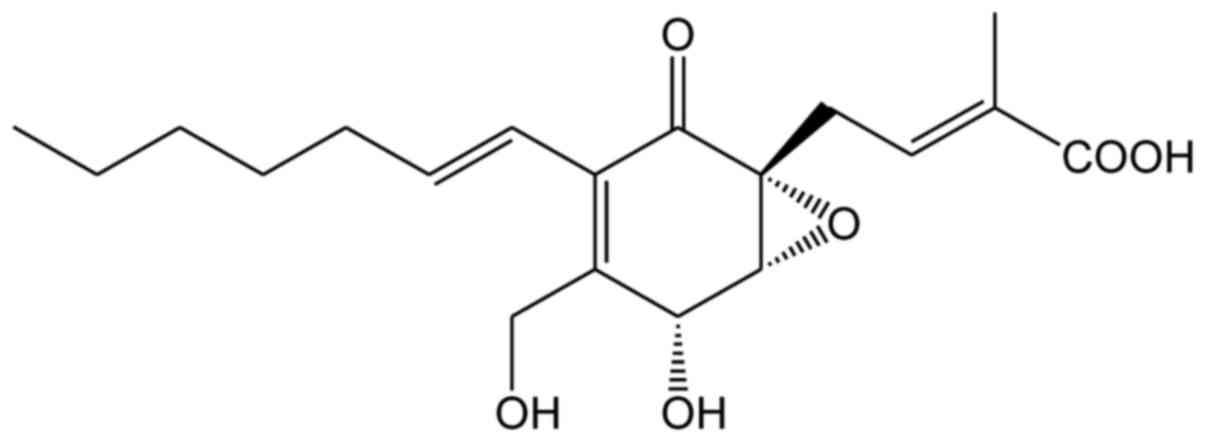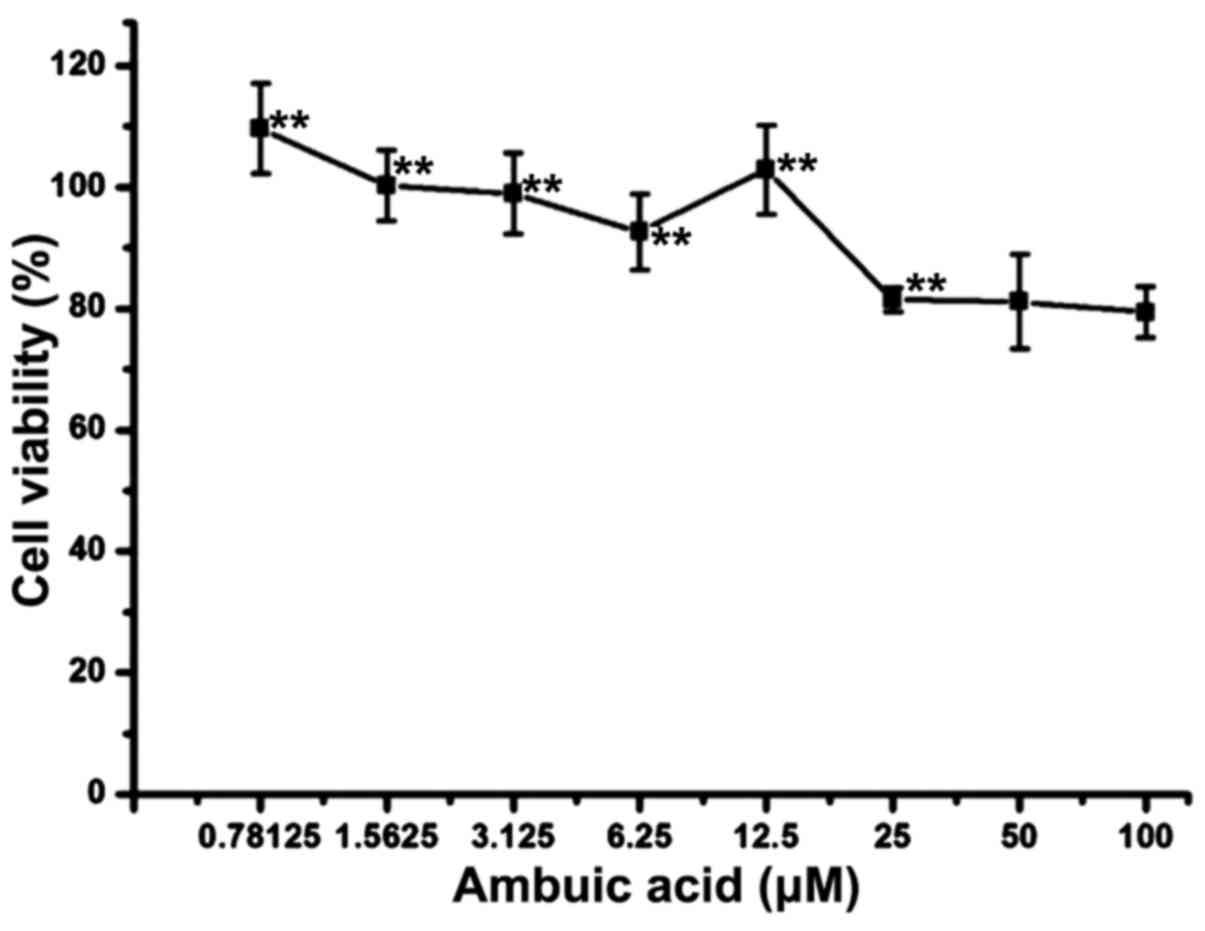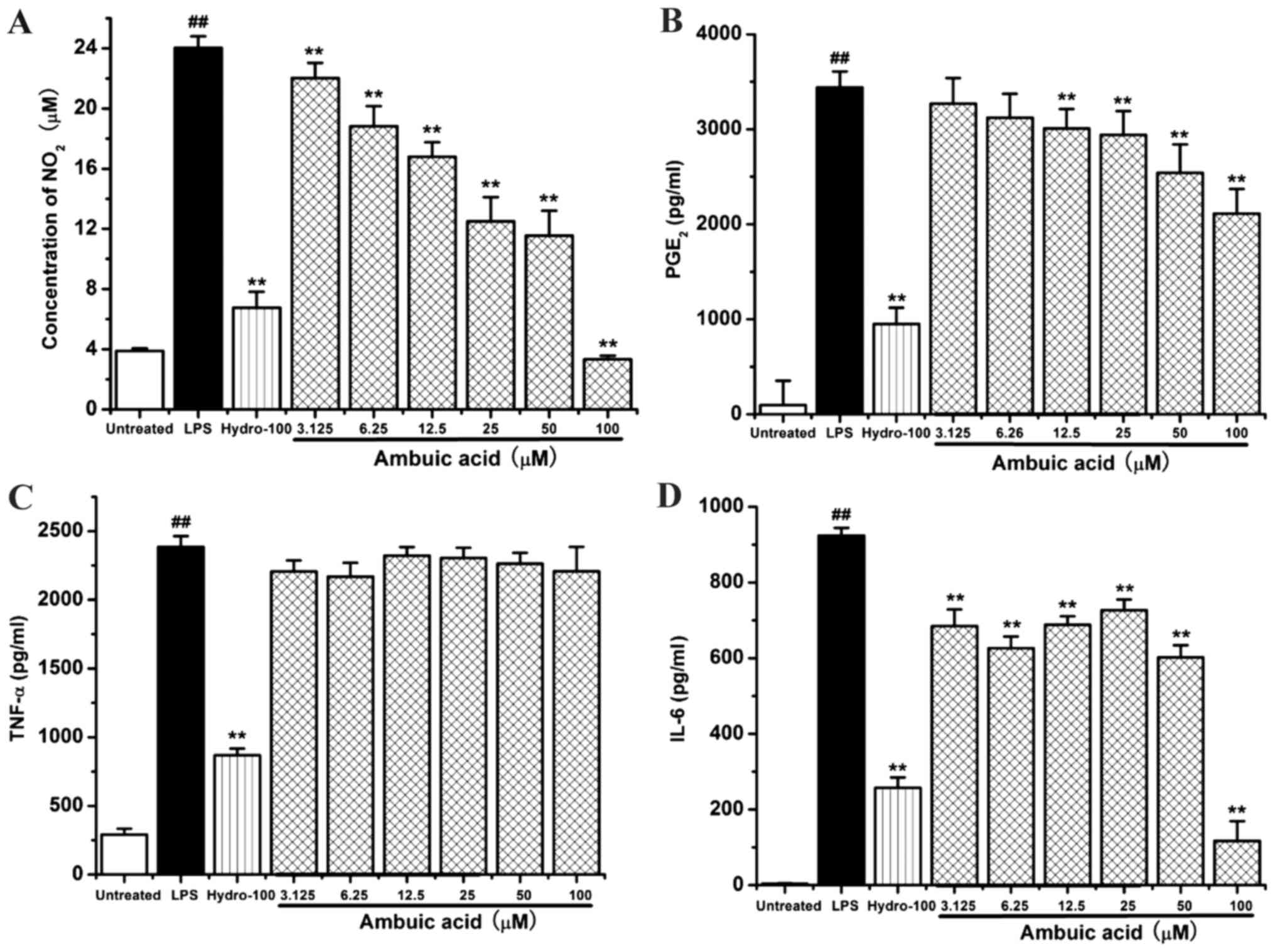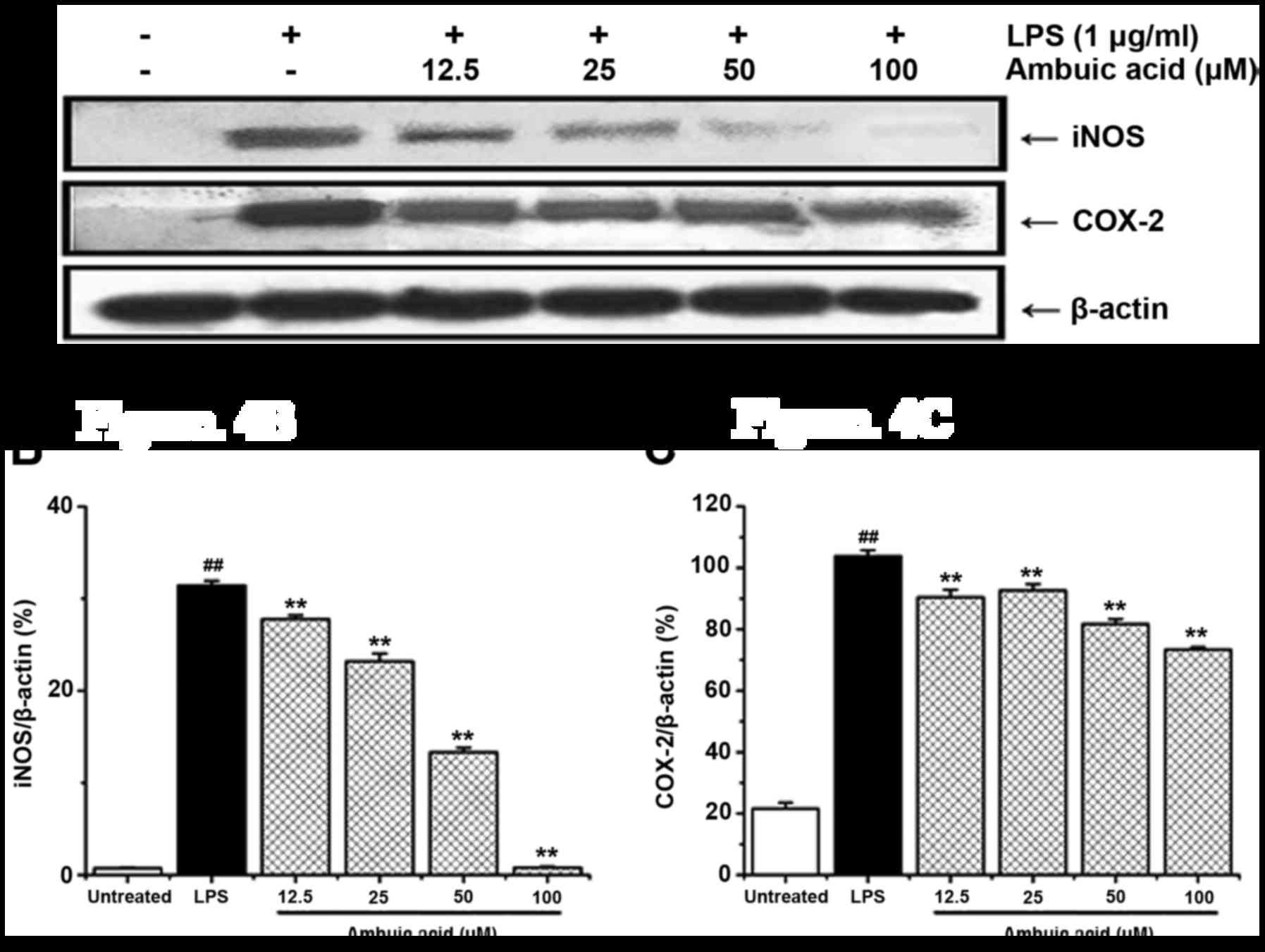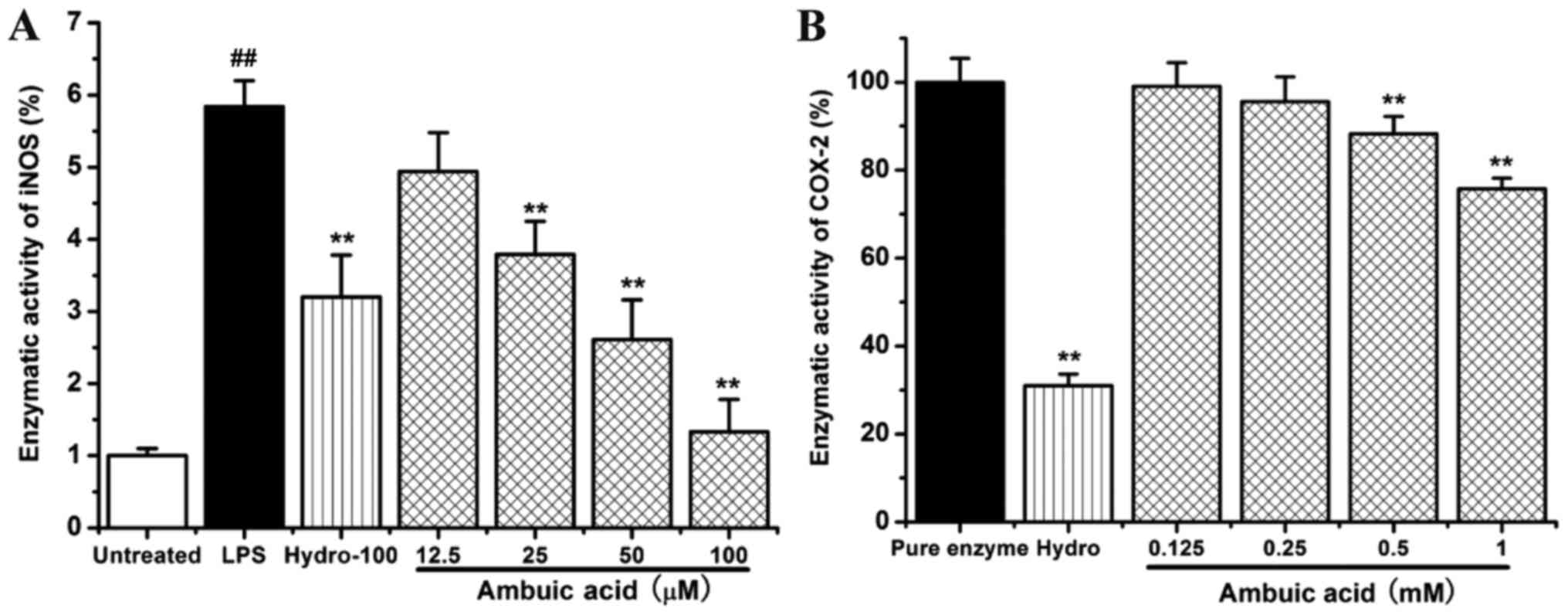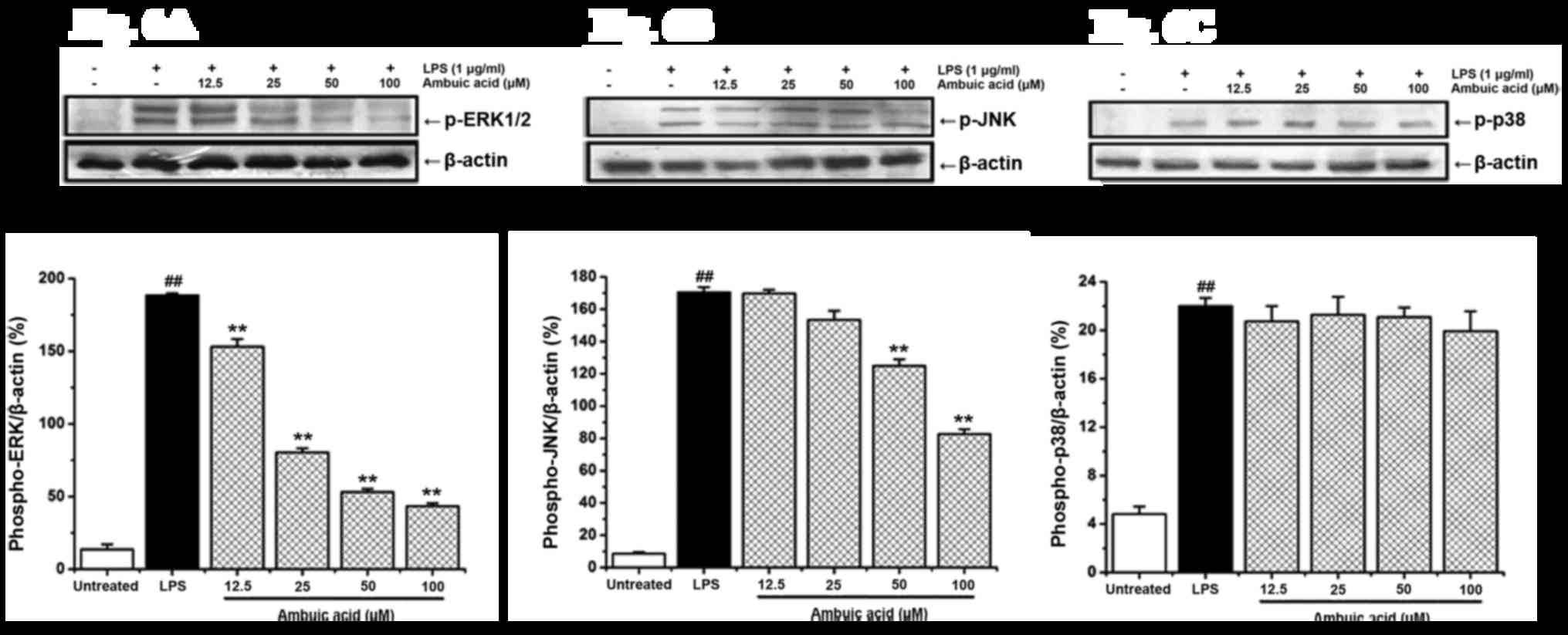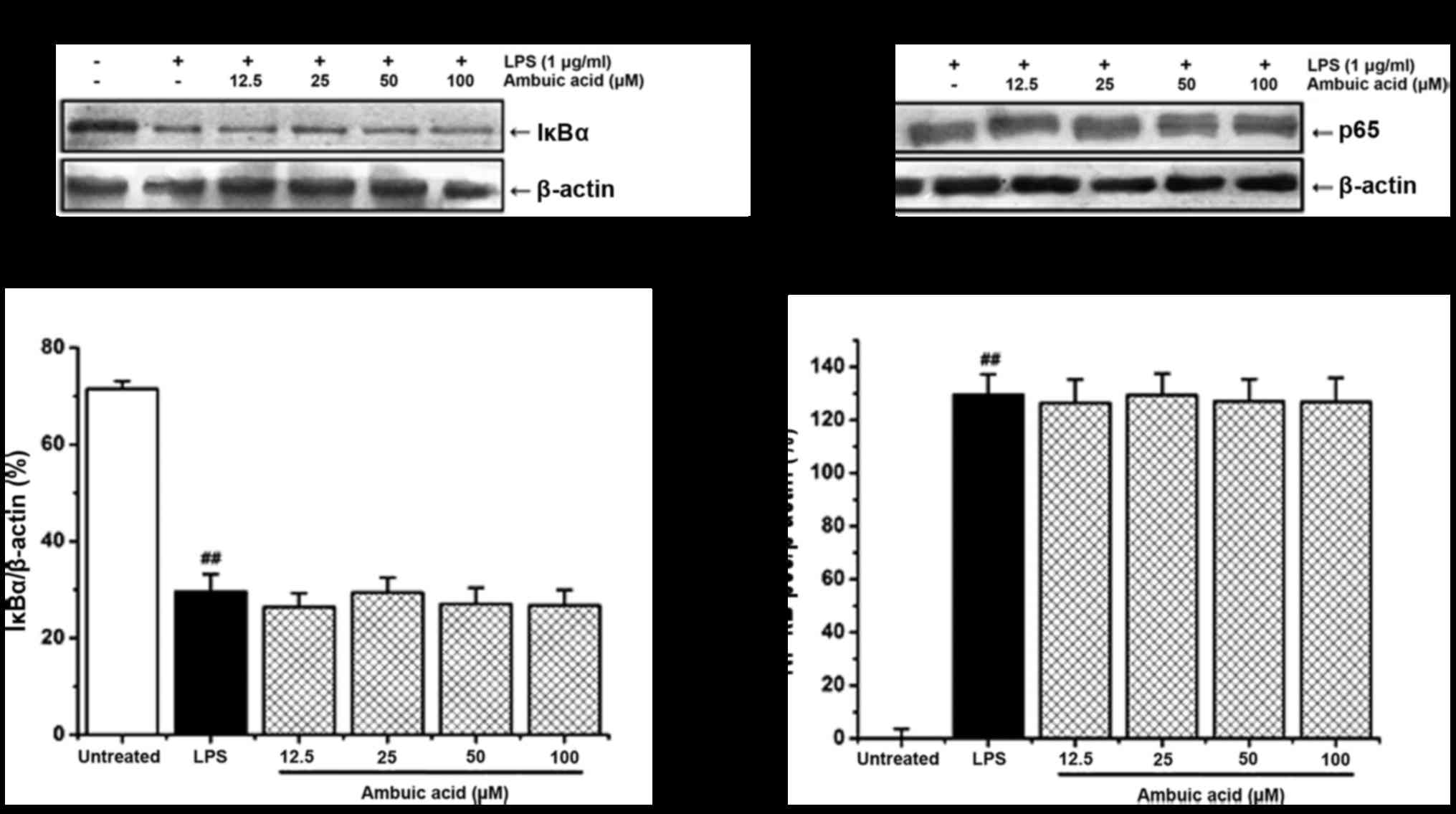Anti‑inflammatory action of ambuic acid, a natural product isolated from the solid culture of Pestalotiopsis neglecta, through blocking ERK/JNK mitogen‑activated protein kinase signaling pathway
- Authors:
- Published online on: June 12, 2018 https://doi.org/10.3892/etm.2018.6294
- Pages: 1538-1546
Abstract
Introduction
The endophytic is a fungi of the genus Pestalotiopsis which exists widely in many plants of different families, have received wide attention because of their ability in producing a variety of secondary metabolites, such as caryophyllene sesquiterpenoids (1,2), disseminins and spiciferone analogues (3), prenyldepside and coumarins (4), diphenyl ether derivatives (5), benzannulated spiroketals (6), chromones (7), 1,3-dihydro isobenzofuran (8), epoxyquinols (9), and polyketide derivatives (10). It is reported that the well-known anticancer drug taxol has been found from several cultivated species of the genus Pestalotiopsis, which provides another alternative way to produce such valuable anti-cancer drugs (11,12). The active secondary metabolites produced by the endophytic fungi can stimulate the growth and development of the organisms, or improve the ability of the host to resist the external environment (13). Pharmacological researches have revealed that the secondary metabolites from species of Pestalotiopsis possess diverse pharmacological properties, including antimicrobial activity (14–16), antiviral (17), antitumor (18), anti-diabetic activity (19), immunomodulatory activity (20), anticestodal activity (21), antioxidant and antihypertensive properties (22), and 20S proteasome inhibitory activity (23).
Ambuic acid (chemical structure shown in Fig. 1) was firstly reported as a novel functionalized cyclohexenone initially isolated from Pestalotiopsis spp. and Monochaetia sp. in 2001 (24), and its relative stereochemistry was predicted by using a novel solid-state nuclear magnetic resonance (NMR) approach in 2003 (25). Ambuic acid showed a certain inhibitory effect on a variety of plant pathogenic fungi Fusarium solani, Fusarium cubense, Helminthosporium sativum, Diplodia natelensis, Cephalosporium gramineum, Pythium ultimum (24), and it has a certain antimicrobial activity against the Gram-positive bacterium Staphyococcus aureus (26). Ambuic acid can also effect the biosynthesis of cyclic peptide quormones in Gram-positive bacteria and Enterococcus faecalis (27). In our recent studies, a plant pathogenic fungus Pestalotiopsis neglecta (FJ-2) has been separated from the twig of Camellia sinensis growing in Fujian Province of China. Futhermore, four new ambuic acid derivatives together with ambuic acid and three other known ramification, have been isolated and identified from the solid culture of Pestalotiopsis neglecta (28). Inhibitory activities of these compounds against LPS-induced overproduction of nitric oxide (NO) in macrophages have been evaluated. Ambuic acid exhibited strong inhibitory activity with IC50 value of 20.80±1.41 µM, which was even much potent than the positive control drug.
Macrophages play an important role in providing immediate defense against foreign stimuli. Lipopolysaccharide (LPS)-mediated overproduction of NO and subsequent inflammatory reaction by macrophages is proved to be closely associated with many pathogenic diseases, including rheumatoid arthritis (29), cancer (30), atherosclerosis (31), and hepatitis (32). By reducing NO formation or removing NO molecule, NO inhibitors may be used as powerful therapeutic anti-inflammatory agents (33). In the present paper, the anti-inflammatory effect of ambuic acid as a NO inhibitor was firstly investigated and the molecular mechanism of the anti-inflammatory action of ambuic acid was absolutely elucidated.
Materials and methods
Fungal material
The pathogenic strain (FJ-2) used in this work was separated from the twig of Camellia sinensis growing in Fujian Province of China. The identification of fungus was based on the (deoxyribonucleic acid) DNA sequences of the ITS1-5.8S-ITS2, and the ITS regions of their ribosomal ribonucleic acid (RNA) gene. We have submitted the sequence data derived from the fungal strain and stored them at GenBank with accession number KJ719299. The result of BLAST search showed that the similarity between the sequence and the sequence of Pestalotiopsis neglecta (Thüm.) was 99%. It was stored in GenBank with the accession number of JX854541.
The fungal strain was placed on the slants of potato dextrose agar and cultured at 25°C for 10 days. We inoculated the agar plugs in 500 ml Erlenmeyer flask, it contains 120 ml of media (0.4% glucose, 1% malt extract, and 0.4% yeast extract, before sterilization the final pH of the medium was adjusted to 6.5), and it was incubated at 25°C on a rotary shaker at 180 rpm for 4 days. Large scale fermentation taked place in 40 bottles of 500 ml Fernbach flasks, which containing 80 g of rice and 100 ml of distilled water. Each flask was inoculated with 10.0 ml of culture medium and cultured at 25°C for 40 days.
Isolation and identification of ambuic acid
The ethyl acetate was used to extract the fermented rice substrate, and the organic solvent was decompressed and concentrated to obtain the crude extract, silica gel column chromatography (CC) with a gradient of n-hexane-ethyl acetate, dichloromethane-methanol were used to divided them into five groups (A-E).
Fraction C was treated with dichloromethane-methanol and subjected to ODS CC eluting with a gradient of methanol in water (10%~100%) to obtain twenty-one subfractions (C1-C21). Subfraction C13 was separated by RP-HPLC using 63% methanol in water to afford ambuic acid. Its chemical structure was validated by extensive NMR experiments and validated by comparison with the data previously incorpratated into the databases of SciFinder Scholar and PubChem. The purity was determined using high-performance liquid chromatography (HPLC; Waters 600; Waters Corp., Milford, MA, USA) and a ultraviolet detector (Waters 490; Waters Corp.); peak area was normalized and the purity of ambuic acid was 98.7%.
Chemicals and reagents
Fetal bovine serum (FBS) and RPMI 1640 culture medium were purchased from Invitrogen (Thermo Fisher Scientific, Inc., Waltham, MA, USA). LPS, DMSO, MTT, PMSF and all other chemicals were obtained from Sigma-Aldrich; Merck KGaA (Darmstadt, Germany). Hydrocortisone succinate (080–05581, Lot CTE6574) was product of Wako Pure Chemical Industries, Ltd. (Osaka, Japan). NO concentration determination kit, mouse prostaglandin E2 (PGE2) ELISA kit, mouse tumor necrosis factor-α (TNF-α) ELISA kit, mouse interleukin-6 (IL-6) ELISA kit, and BCA protein concentration assay kit were purchased from Yantai Science and Biotechnology Co., Ltd. (Shandong, China). NO synthase (NOS) assay kit (fluorimetric method) was product of Beyotime Institute of Biotechnology (Haimen, China). COX colorimetric inhibitor screening assay kit (701050) was product of Cayman Chemical Company (Ann Arbor, MI, USA). Mouse anti-rabbit inducible NOS (iNOS) polyclonal antibody (160862) and mouse anti-rabbit cyclooxygenase-2 (COX-2) polyclonal antibody (160106) were purchased from Cayman Chemical Company. Goat anti-rabbit phosphorylated c-Jun N-terminal kinase (p-JNK) polyclonal antibody (AF3318), goat anti-rabbit phosphorylated extracellular signal-regulated kinase 1/2 (p-ERK 1/2) polyclonal antibody (AF1015), goat anti-rabbit phosphorylated p38 (p-p38) polyclonal antibody (AF3455), and horseradish peroxidase (HRP)-conjugated goat anti-rabbit IgG (H+L) (S0001) were products of Affinity Biosciences. Goat anti-rabbit IκB-α polyclonal antibody (sc-371), mouse monoclonal nuclear transcription factor-κB (NF-κB) p65 antibody (sc-8008), and goat anti-rabbit β-actin polyclonal antibody (sc-1616) were purchased from Santa Cruz Biotechnology, Inc. A solution for dissolving ambuic acid with 100% cell culture grade dimethyl sulfoxide (DMSO) into 50 mM and stored as small aliquots at −20°C and then diluted it to desired concentrations prior to use.
Cell culture
Mouse monocyte-macrophage RAW264.7 cells (ATCC TIB-71; American Type Culture Collection, Manassas, VA, USA) were cultured in RPMI-1640 medium supplemented with 10% heat inactivated FBS in a humidified incubator with 95% air and 5% CO2 at 37°C. Every two days, the medium was routinely changed. When the cells attained about 80% confluence, they were passaged.
MTT assay for cytotoxicity
Using the measured of mitochondrial-dependent reduction of MTT to formazan to measure the cytotoxicity (34). RAW264.7 cells were seeded in 96-well plates at the density of 1×106 cells/ml. After 1 h of incubation, the cells were treated with serially diluted ambuic acid (the concentrations were from 0.78125 to 100 µM) and incubated for 24 h. After treatment, adding MTT solution with the concentration of 200 µg/ml, and set the cells to the incubator for another 4 h at 37°C. Removing the medium and adding 150 µl of DMSO to dissolve the formazan. Using the microplate reader at 570 nm to measure the absorbance of each group and using a reference wavelength at 630 nm (Biotek Synergy HT; BioTek Instruments, Inc., Winooski, VT, USA). The control group, consisting of untreated cells, was considered to be 100% viable. Final results are expressed as percentage of viable cells of the experimental group when compared with those of the control group.
NO analysis
NO was determined through measuring the nitrite concentration in the cell culture supernatant by using Griess reagent (mixture of equal amount of reagent A and reagent B; A: 1% sulphanilamide in 5% H3PO4, B: 0.1% naphthylethylene diamine dihydrochloride) (35). RAW264.7 cells were seeded in 96-well plates at the density of 1×106 cells/ml. After 1 h incubation, the cells were treated by LPS (1 µg/ml) with or without ambuic acid (3.125, 6.25, 12.5, 25, 50, 100 µM), or hydrocortisone succinate (100 µM) and then incubated for 24 h. 100 µl of the cell culture supernatant was mixed with 100 µl of Griess reagent and shaked for 10 min at room temperature. The absorbance was measured at 540 nm, and using a standard calibration curve to calculate the nitrite concentrations which was prepared from a range of different concentrations of sodium nitrite.
PGE2 concentration determination
PGE2, a pro-inflammatory mediator, is produced by COX-2. RAW264.7 cells were treated by LPS (1 µg/ml) with or without ambuic acid (3.12, 6.25, 12.5, 25, 50, 100 µM), or hydrocortisone succinate (100 µM) for 24 h. The cell culture supernatant of 100 µl was removed to determine the level of PGE2 by using a commercial mouse PGE2 ELISA kit according to the manufacturer's recommendations. The ELISA data representing mean values ± SD (standard deviation) were obtained in duplicate from three independent experiments (36).
Measurement of cytokines TNF-α and IL-6
RAW264.7 cells were seeded in 96-well plates at the density of 5×105 cells/ml. After 1 h incubation, the cells were treated by LPS (1 µg/ml) with or without ambuic acid (3.12, 6.25, 12.5, 25, 50, 100 µM), or hydrocortisone succinate (100 µM) for 6 h. 100 µl of the culture supernatants was collected to determine the levels of TNF-α or IL-6 by using respective ELISA kit according to the manufacturer's recommendations (37). The ELISA data representing mean values ± SD were obtained in duplicate from three independent experiments.
Assay of iNOS enzymatic activity
Methods for the determination of iNOS enzymatic activity as previously reported (38). Briefly, after the treatments, removing the culture supernatant, and adding 100 µl of NOS assay buffer (1X). Then adding 100 µl of NOS assay reaction solution and incubated for 2 h at 37°C. Using fluorescence microplate reader measured the fluorescence at excitation wavelength of 485 nm and emission wavelength of 528 nm.
Assay of COX-2 enzymatic activity
The enzymatic activity of COX-2 was determined in a cell-free system by using a COX colorimetric inhibitor screening assay kit according to the manufacturer's instructions (38). Briefly, 160 µl of assay buffer, 10 µl of heme, and 10 µl of DMSO were added to the background wells. 150 µl of assay buffer, 10 µl of COX-2 enzyme, 10 µl of heme, and 10 µl of DMSO were added to the 100% initial activity wells. 150 µl of assay buffer, 10 µl of COX-2 enzyme, 10 µl of heme, and 10 µl of ambuic acid or hydrocortisone succinate were added to the sample wells. The plate was gently shaken for a few sec and then incubated for five min at 25°C. Adding 20 µl of the colorimetric substrate solution and then adding 20 µl of arachidonic acid to all the wells. Shaking the plate carefully for a few sec and incubating it for five min at 25°C. The absorbance was measured at 590 nm by using a microplate reader, and the enzymatic activity of COX-2 was calculated when compared with the 100% initial activity wells according to the manufacturer's instructions.
Total protein extraction
To determination the expression of iNOS and COX-2 proteins, adding the LPS (1 µg/ml) to the RAW264.7 cells with or without indicated concentrations of ambuic acid for 24 h. Then washing it with ice-cold phosphate-buffered saline (PBS), harvesting the cells and adding 40 µl of cold lysis buffer [10% NP-40, 150 mM NaCl, 10 mM Tris, 2 mM PMSF, 5 µM leupeptin, pH 7.6] to lyse the cell. For determination of phospho-JNK, phospho-ERK 1/2, and phospho-p38 proteins, added the LPS (1 µg/ml) to the RAW264.7 cells with or without indicated concentrations of ambuic acid for 30 min. Then washing it with ice-cold PBS, harvesting the cells and adding 40 µl of the same cold lysis buffer mentioned above to lyse the cell. After incubating at 4°C for 15 min, centrifuging it at 15,000 × g for 10 min at 4°C, the total proteins were separated and used for western blot analysis.
Cytoplasmic and nuclear protein extraction
After proper treatments, removing the media, and washing the cells with ice-cold PBS, then harvesting the cells and adding 40 µl of buffer A [10 mM HEPES, 1.5 mM MgCl2, 10 mM KCl, 500 µM DTT, 0.1% (v/v) NP-40] to lyse the cell. After incubating at 4°C for 15 min, centrifuging it at 12,000 × g for 5 min at 4°C, the cytoplasmic proteins were separated and used for western blot analysis of IκB-α. The ectraction of nuclei pellet is to suspend precipitation in 30 µl of buffer B [20 mM HEPES, 1.5 mM MgCl2, 400 mM NaCl, 100 mM DTT, 20 µM PMSF] and incubated for 20 min at 4°C. By centrifuging at 16,000 × g for 10 min at 4°C, the supernatant was separated as nuclear protein and used for western blot analysis of NF-κB p65 subunit.
Western blotting
Using the BCA protein concentration assay kit to determine the protein concentration of each aliquot, and the suspensions were boiled with SDS-PAGE loading buffer. The 30 µg of protein in each sample were transferred to the nitrocellulose membranes by SDS-PAGE and electrophoretically. The membranes were blocked with 5% non-fat dried milk in Tris-buffered saline and Tween-20 (TBST, 20 mM Tris-HCl, 150 mM NaCl, 0.05% Tween-20) for 4 h at room temperature. After washed with TBST, incubating the membranes in respective primary antibody solution (anti-iNOS, anti-COX-2, anti-phospho-JNK, anti-phospho-ERK, anti-phospho-p38, anti-IκB-α, anti-p65, and anti-β-actin antibody) overnight at 4°C. Washing the membranes with TBST and then incubating them with HRP-conjugated secondary antibody solution for 1 h at room temperature. The membranes were washed three times with TBST and the blots were detected by using enhanced chemiluminescence reagent (ECL) and exposed to photographic films (Kodak, Rochester, NY, USA). Images were collected and the bands corresponding to iNOS, COX-2, phospho-ERK, phospho-JNK, phospho-p38, IκB-α, p65 and β-actin protein were quantitated by densitometric analysis using the DigDoc100 program (Alpha Ease FC software). Data of iNOS, COX-2, phospho-ERK, phospho-JNK, phospho-p38, IκB-α and p65 were normalized on the basis of β-actin levels.
Statistical analysis
All data were shown as mean ± SD. Significant differences among different treatment groups were analyzed by two-way analysis of variance (ANOVA) followed by the post hoc Bonferroni test. P<0.05 was considered to indicate a statistically significant difference.
Results
Ambuic acid did not exhibit cytotoxicity against RAW264.7 macrophages at the concentrations of 0.78–25 µM
RAW264.7 cells were treated by 0.78–100 µM of ambuic acid for 24 h. MTT assay described in the section of Materials and methods was used to test the cell viability. As shown in Fig. 2, treatment with 100 µM and 50 µM of ambuic acid showed weak cytotoxicity against RAW264.7 cells, but no cytotoxicity was observed at the dose range of 0.78–25 µM.
Effect of ambuic acid on the NO and PGE2 production
RAW264.7 cells were treated by 1 µg/ml of LPS with or without ambuic acid (3.125, 6.25, 12.5, 25, 50, 100 µM), or hydrocortisone succinate (100 µM) for 24 h. The concentration of nitrite (NO2−) was monitored by Griess assay as indicator of NO production, and the level of PGE2 was determined by ELISA. Hydrocortisone succinate was used as a positive control drug. As shown in Fig. 3A, ambuic acid significantly inhibited the overproduction of NO induced by LPS in a dose-dependent manner. However, the production of PGE2 induced by LPS was only weakly inhibited by ambuic acid (Fig. 3B).
Effect of ambuic acid on the TNF-α and IL-6 release
RAW264.7 cells were treated by 1 µg/ml of LPS with or without ambuic acid (3.125, 6.25, 12.5, 25, 50 and 100 µM), or hydrocortisone succinate (100 µM) for 6 h. The levels of pro-inflammatory cytokine TNF-α and IL-6 were measured by using respective ELISA kit. As shown in Fig. 3C, the positive control group hydrocortisone succinate potently can effectively inhibit the release of inflammatory factor TNF-α induced by LPS. However, ambuic acid did not show any significant inhibitory activity on the release of inflammatory factor TNF-α. As shown in Fig. 3D, ambuic acid significantly inhibited the release of IL-6 induced by LPS in a dose-dependent manner.
Effect of ambuic acid on the expression of iNOS and COX-2 proteins
As the overproduction of NO and PGE2 is always correlated with the high expression of iNOS and COX-2 proteins, and we currently using Western blot analysis to investigate the expression of iNOS together with COX-2 protein. As shown in Fig. 4A, the expression of iNOS and COX-2 proteins was potently increased after stimulation of LPS for 24 h. Ambuic acid can markedly down regulated the expression of iNOS protein in a dose-dependent manner, which strongly suggested that the decrease of NO production was due to the inhibitory effect of ambuic acid on the suppression of iNOS expression. Furthermore, ambuic acid also inhibited the expression of COX-2 protein. The density of bands corresponding to the iNOS and COX-2 proteins were standardized on the basis of β-actin and shown in Fig. 4B and C, respectively.
Effect of ambuic acid on the iNOS and COX-2 enzymatic activity
RAW264.7 cells were treated by 1 µg/ml of LPS with or without indicated concentrations of ambuic acid (12.5, 25, 50 and 100 µM) or hydrocortisone succinate (100 µM). The inhibitory effect of ambuic acid at different concentration on the activity of iNOS enzymatic activity was detected by fluorimetric method. As shown in Fig. 5A, LPS treatment caused about a six-fold increase of iNOS enzymatic activity within 120 min. Ambuic acid could significantly inhibit the activity of iNOS enzymatic induced by LPS in RAW264.7 cells and showed a good dose-dependency.
The inhibitory effect of ambuic acid on the COX-2 enzymatic activity was examined by the cell-free colorimetric method. As shown in Fig. 5B, ambuic acid also inhibited the COX-2 enzymatic activity.
Effect of ambuic acid on the activation of mitogen-activated protein kinase (MAPK) signaling pathway
Previous studies have already demonstrated that the MAPK signaling pathways are associated with the upregulation of LPS-induced inflammatory responses. LPS activates MAPKs including the protein kinases ERK 1/2, JNK and p38 kinase. In order to investigate whether the three MAPK protein pathways are involved in the anti-inflammatory responses by ambuic acid, LPS-induced phosphorylation of ERK1/2, JNK and p38 in RAW264.7 cells were examined by Western blot analysis. As shown in Fig. 6, LPS treatment significantly induced the phosphorylation of ERK 1/2, JNK and p38. Ambuic acid could remarkably reduced LPS-induced phosphorylation of ERK1/2 and JNK in a dose-dependent manner, whereas phosphorylation of p38 was not affected. The density of bands corresponding to the phospho-ERK, phospho-JNK and phospho-p38 protein was standardized on the basis of β-actin and shown in Fig. 6.
Effect of ambuic acid on the activation of NF-κB signaling pathway
NF-κB translocated to the nucleus always due to the phosphorylation and degradation of IκB-α protein. The effect of ambuic acid on the degradation of IκB-α and the translocation of NF-κB p65 to the nucleus was investigated by Western blot analysis. As shown in Fig. 7A and B, LPS treatment induced the degradation of IκB-α protein and the translocation of NF-κB p65 to the nucleus. However, ambuic acid showed no obvious suppression on both the degradation of IkB-α protein and the translocation of NF-κB p65 to the nucleus.
Discussion
Ambuic acid has been reported to show a certain inhibitory effect on a variety of plant pathogenic fungi Fusarium solani, Fusarium cubense, Helminthosporium sativum, Diplodia natelensis, Cephalosporium gramineum, Pythium ultimum (24), and it has a certain antimicrobial activity against the Gram-positive bacterium Staphyococcus aureus (26). Ambuic acid can also effect the biosynthesis of cyclic peptide quormones in Gram-positive bacteria Enterococcus faecalis (27). Our research group firstly found that ambuic acid significantly inhibited LPS-induced overproduction of NO, an important pro-inflammatory mediator that could promote the expression of some enzymes implicated in diverse human inflammatory diseases. These results imply the potential anti-inflammatory effect of ambuic acid and its related derivatives. The present study was designed to elucidate the anti-inflammatory effects of ambuic acid, as well as to elucidate its molecular mechanism.
As shown in the results, ambuic acid strongly inhibited various LPS-induced responses of macrophages including the NO overproduction, the PGE2 production, and the release of pro-inflammatory cytokine IL-6. This is the first direct evidence to show that the ambuic acid has an anti-inflammatory effect. To further investigate the possible anti-inflammatory molecular mechanism of ambuic acid, the effect on the expression of iNOS and COX-2 proteins, the effect on the enzymatic activity of iNOS and COX-2 enzymes, the effect on the activation of MAPK pathway and NF-κB pathway were further investigated.
The Toll like receptor is a superfamily of receptors that are mainly distributed in inflammatory cells to identify pathogen molecules, among them, TLR4 mainly identified the LPS that is the component of gram negative bacteria cell wall. Activation of myeloid activating factor 88 dependent and non dependent two signal pathway pathways in combination with LPS and TLR4. The former activates MAPK and NF-κB signaling pathways, the latter activates the NF-κB and interferon regulatory factor-3 (IRF3) signaling pathways. Through these signaling pathways, TLR4 induces inflammatory cells to release inflammatory factors that mediate inflammatory responses. RAW264.7 cells have been shown to express TLR4 in the literature, and LPS is able to recognize TLR4 receptors on macrophages and activate macrophages to produce inflammatory factors (39).
MAPK cascades have been shown to be important in the transduction of extracellular signals to cellular immune responses (40). In mammalian cells, three MAPK families have been clearly characterized: classical MAPK, also known as ERK, JNK/MAPK (JNK/SAPK) and p38 kinase. The MAPK pathways relay, amplify and integrate signals from a diverse range of stimuli, and elicit appropriate physiological responses, including inflammatory responses, cellular proliferation, differentiation and apoptosis in mammalian cells. LPS can activate the ERK, JNK and p38 MAPK signaling pathways, which can promote the production of pro-inflammatory cytokines and the expression of iNOS and COX-2 proteins (41,42). Thus, the MAPK signaling pathways are vital approaches to regulate inflammatory responses, and are also considered suitable targets for anti-inflammatory therapy (43).
NF-κB plays an important role in many cellular responses to environmental changes so it is the most valuable transcription factor. NF-κB complex containing the p50 and the p65 subunits exists in the cytoplasm in a latent form, which is stabilized by an inhibitory subunit called IκB-α (44,45). After stimulation of cells with LPS, IκB-α becomes phosphorylated followed by a rapidly protein degradation. As a result, NF-κB is activated and translocates into the nucleus promptly.
Our results demonstrated that ambuic acid strongly inhibited both the expression of iNOS protein and the enzymatic activity of iNOS enzyme in a dose-dependent manner, which strongly suggested that the decrease of NO production was due to the suppression of iNOS expression and enzymatic activity. Ambuic acid also inhibited the expression of COX-2 protein and the enzymatic activity of COX-2 enzyme, which indicated that the decrease of PGE2 production was due to the suppression of COX-2 expression and enzymatic activity. Further investigations showed that ambuic acid suppressed the phosphorylation of ERK and JNK proteins, but did not suppress the phosphorylation of p38 protein. Ambuic acid showed no obvious inhibition on the degradation of IκB-α protein and the translocation of NF-κB to the nucleus. In conclusion, ambuic acid exerts anti-inflammatory effect through inhibiting LPS-induced production of much pro-inflammatory mediators such as NO, PGE2 and IL-6, and its molecular mechanism was proved to be via blocking the ERK/JNK MAPK signaling pathway but has no concern with the inactivation of NF-κB pathway.
The mechanism of inflammation is that LPS combines with TLR4 receptors on macrophages to stimulate the release of inflammatory factors such as NO, TNF-α, IL-6 and PGE2, and can activate the high expression of upstream protein MAPK signaling pathway and downstream proteins iNOS and COX-2. In the experiment, the cells were cultured, and then add the ambuic acid after a period of incubation, the medium was changed, and the cells were washed to remove the medium of ambuic acid, then add LPS, it combines with the TLR4 cell receptor, which can prevent the reaction of LPS and ambuic acid, and appear the false positive results.
From the experimental results we can see that ambuic acid may have mediated changes in the production of inflammatory cytokines by RAW264.7 cells by influencing the ability of LPS to bind to TLR4. In the future studies will investigate the role of TLR4 in the ambuic acid-mediated reduction of pro-inflammatory cytokines in RAW264.7 cells and investigate the mechanisms underlying the ambuic acid-mediated reduction in pro-inflammatory cytokines using specific inhibitors of ERK and JNK.
Acknowledgements
Not applicable.
Funding
The present study was supported by the Ministry of Science and Technology of China (grant nos. 2014CB138304 and 2012ZX09301002-003), The National Nature Science Foundation (grant no. 21472233), The Youth Innovation Promotion Association of Chinese Academy of Sciences (grant no. 2014074) and The Shandong Provincial Natural Science Foundation (grant no. ZR2016HL54).
Availability of data and materials
All data generated or analyzed during this study are included in this published article.
Authors' contributions
HuL cultured the cells and detected the cytotoxicity of ambuic acid by MTT assay. YL and PL determined the concentration of nitric oxide and PGE2. LW and DL determined the concentration of TNF-α and IL-6. MW and QZo analyzed the enzymatic activity of iNOS and COX-2. Protein extraction was carried out by KM. The first authors QZh and RL detected the extracted protein by western blotting, and performed statistical analysis of the data; they were also major contributors in writing the manuscript. HoL purified and identified ambuic acid. HoL and FZ conducted the experimental design and manuscript writing. All authors read and approved the final manuscript.
Ethics approval and consent to participate
Not applicable.
Consent for publication
Not applicable.
Competing interests
The authors declare that they have no competing interests.
References
|
Liu Y, Yang MH, Wang XB, Li TX and Kong LY: Caryophyllene sesquiterpenoids from the endophytic fungus, Pestalotiopsis sp. Fitoterapia. 109:119–124. 2016. View Article : Google Scholar : PubMed/NCBI | |
|
Deyrup ST, Swenson DC, Gloer JB and Wicklow DT: Caryophyllene sesquiterpenoids from a fungicolous isolate of Pestalotiopsis disseminata. J Nat Prod. 69:608–611. 2006. View Article : Google Scholar : PubMed/NCBI | |
|
Hwang IH, Swenson DC, Gloer JB and Wicklow DT: Disseminins and spiciferone analogues: Polyketide-derived metabolites from a fungicolous isolate of Pestalotiopsis disseminate. J Nat Prod. 79:523–530. 2016. View Article : Google Scholar : PubMed/NCBI | |
|
Yang XL, Awakawa T, Wakimoto T and Abe I: Induced production of novel prenyldepside and coumarins in endophytic fungi Pestalotiopsis acaciae. Tetrahedron Lett. 54:5814–5817. 2013. View Article : Google Scholar | |
|
Klaiklay S, Rukachaisirikul V, Tadpetch K, Sukpondma Y, Phongpaichit S, Buatong J and Sakayaroj J: Chlorinated chromone and diphenyl ether derivatives from the mangrove-derived fungus Pestalotiopsis sp. PSU-MA69. Tetrahedron. 68:2299–2305. 2012. View Article : Google Scholar | |
|
Li J, Li L, Si Y, Jiang X, Guo L and Che Y: Virgatolides A-C, benzannulated spiroketals from the plant endophytic funfus Pestalotiopsis virgatula. Org Lett. 13:2670–2673. 2011. View Article : Google Scholar : PubMed/NCBI | |
|
Xu J, Kjer J, Sendker J, Wray V, Guan H, Edrada R, Lin W, Wu J and Proksch P: Chromones from the endophytic fungus Pestalotiopsis sp. isolated from the chinese mangrove plant Rhizophora mucronata. J Nat Prod. 72:662–665. 2009. View Article : Google Scholar : PubMed/NCBI | |
|
Harper JK, Arif AM, Ford EJ, Strobel GA, Porco JA Jr, Tomer DP, Oneill KL, Heider WM and Grant DM: Pestacin: A 1,3-dihydro isobenzofuran from Pestaliopsis microspora possessing antioxidant and antimycotic activities. Tetrahedron. 59:2471–2474. 2003. View Article : Google Scholar | |
|
Akone SH, Amrani ME, Lin W, Lai D and Proksch P: Cytosporins F-K, new epoxyquinols from the endophytic fungus Pestalotiopsis theae. Tetrahedron Lett. 54:6751–6754. 2013. View Article : Google Scholar | |
|
Xu J, Aly AH, Wray V and Proksch P: Polyketide derivatives of endophytic fungus Pestalotiopsis sp. isolated from the Chinese mangrove plant Rhizophora mucronata. Tetrahedron Lett. 52:21–25. 2010. View Article : Google Scholar | |
|
Strobel G, Yang X, Sears J, Kramer R, Sidhu RS and Hess WM: Taxol from Pestalotiopsis microspora, an endophytic fungus of Taxus wallachiana. Microbiology. 142:435–440. 1996. View Article : Google Scholar : PubMed/NCBI | |
|
Kumaran RS, Kim HJ and Hur BK: Taxol-producing [corrected] fungal endophyte, Pestalotiopsis species isolated from Taxus cuspidata. J Biosci Bioeng. 110:541–546. 2010. View Article : Google Scholar : PubMed/NCBI | |
|
Tan RX and Zou WX: Endophytes: A rich source of functional metabolites. Nat Prod Rep. 18:448–459. 2001. View Article : Google Scholar : PubMed/NCBI | |
|
Ding G, Liu S, Guo L, Zhou Y and Che Y: Antifungal metabolites from the plant endophytic fungus Pestalotiopsis foedan. J Nat Prod. 71:615–618. 2008. View Article : Google Scholar : PubMed/NCBI | |
|
Wei MY, Li D, Shao CL, Deng DS and Wang CY: (±)-Pestalachloride D, an antibacterial racemate of chlorinated benzophenone derivative from a soft coral-derived fungus Pestalotiopsis sp. Mar Drugs. 11:1050–1060. 2013. View Article : Google Scholar : PubMed/NCBI | |
|
Xu D, Zhang BY and Yang XL: Antifungal monoterpene derivatives from the plant endophytic fungus Pestalotiopsis foedan. Chem Biodivers. 13:1422–1425. 2016. View Article : Google Scholar : PubMed/NCBI | |
|
Jia YL, Wei MY, Chen HY, Guan FF, Wang CY and Shao CL: (+)- and (−)-pestaloxazine A, a pair of antiviral enantiomeric alkaloid dimers with a symmetric spiro[oxazinane-piperazinedione] skeleton from Pestalotiopsis sp. Org Lett. 17:4216–4219. 2015. View Article : Google Scholar : PubMed/NCBI | |
|
Chen L, Zhang QY, Jia M, Ming QL, Yue W, Rahman K, Qin LP and Han T: Endophytic fungi with antitumor activities: Their occurrence and anticancer compounds. Crit Rev Microbiol. 42:454–473. 2016.PubMed/NCBI | |
|
Kiho T, Itahashi S, Sakushima M, Matsunaga T, Usui S, Ukai S, Mori H, Sakamoto H and Ishiguro Y: Polysaccharides in fungi. XXXVIII. Anti-diabetic activity and structural feature of a galactomannan elaborated by Pestalotiopsis species. Biol Pharm Bull. 20:118–121. 1997. View Article : Google Scholar : PubMed/NCBI | |
|
Kumar DS, Lau CS, Wan JM, Yang D and Hyde KD: Immunomodulatory compounds from Pestalotiopsis leucothës, an endophytic fungus from Tripterygium wilfordii. Life Sci. 78:147–156. 2005. View Article : Google Scholar : PubMed/NCBI | |
|
Verma VC, Gangwar M, Yashpal M and Nath G: Anticestodal activity of endophytic Pestalotiopsis sp. on protoscoleces of hydatid cyst Echinococcus granulosus. Biomed Res Int. 2013:3085152013. View Article : Google Scholar : PubMed/NCBI | |
|
Tejesvi MV, Kini KR, Prakash HS, Subbiah V and Shetty HS: Antioxidant, antihypertensive, and antibacterial properties of endophytic Pestalotiopsis species from medicinal plants. Can J Microbiol. 54:769–780. 2008. View Article : Google Scholar : PubMed/NCBI | |
|
Xia X, Kim S, Liu C and Shim SH: Secondary metabolites produced by an endophytic fungus Pestalotiopsis sydowiana and their 20S proteasome inhibitory activities. Molecules. 21:pii: E944. 2016. View Article : Google Scholar | |
|
Li JY, Harper JK, Grant DM, Tombe BO, Bashyal B, Hess WM and Strobel GA: Ambuic acid, a highly functionalized cyclohexenone with antifungal activity from Pestalotiopsis spp. and Monochaetia sp. Phytochemistry. 56:463–468. 2001. View Article : Google Scholar : PubMed/NCBI | |
|
Harper JK, Barich DH, Hu JZ, Strobel GA and Grant DM: Stereochemical analysis by solid-state NMR: Structural predictions in ambuic acid. J Org Chem. 68:4609–4614. 2003. View Article : Google Scholar : PubMed/NCBI | |
|
Ding G, Li Y, Fu S, Liu S, Wei J and Che Y: Ambuic acid and torreyanin acid derivatives from the endolichenic fungus Pestalotiopsis sp. J Nat Prod. 72:182–186. 2009. View Article : Google Scholar : PubMed/NCBI | |
|
Nakayama J, Uemura Y, Nishiguchi K, Yoshimura N, Igarashi Y and Sonomoto K: Ambuic acid inhibits the biosynthesis of cyclic peptide quormones in gram-positive bacteria. Antimicrob Agents Chemother. 53:580–586. 2009. View Article : Google Scholar : PubMed/NCBI | |
|
Qi QY, Li EW, Han JJ, Pei YF, Ma K, Bao L, Huang Y, Zhao F and Liu HW: New ambuic acid derivatives from the solid culture of Pestalotiopsis neglecta and their nitric oxide inhibitory activity. Sci Rep. 5:99582015. View Article : Google Scholar : PubMed/NCBI | |
|
Ali AM, Habeeb RA, El-Azizi NO, Khattab DA, Abo-Shady RA and Elkabarity RH: Higher nitric oxide levels are associated with disease activity in Egyptian rheumatoid arthritis patients. Rev Bras Reumatol. 54:446–451. 2014.(In Portuguese). View Article : Google Scholar : PubMed/NCBI | |
|
Coulter JA, McCarthy HO, Xiang J, Roedl W, Wagner E, Robson T and Hirst DG: Nitric oxide-a novel therapeutic for cancer. Nitric Oxide. 19:192–198. 2008. View Article : Google Scholar : PubMed/NCBI | |
|
Husain K, Hernandez W, Ansari RA and Ferder L: Inflammation, oxidative stress and rennin angiotensin system in atherosclerosis. World J Biol Chem. 6:209–217. 2015. View Article : Google Scholar : PubMed/NCBI | |
|
Beyazit Y, Efe C, Tanoglu A, Purnak T, Sayilir A, Taskıran I, Kekilli M, Turhan T, Ozaslan E and Wahlin S: Nitric oxide is a potential mediator of hepatic inflammation and fibrogenesis in autoimmune hepatitis. Scand J Gastroenterol. 50:204–210. 2015. View Article : Google Scholar : PubMed/NCBI | |
|
Muscará MN and Wallace JL: Nitric Oxide. V. therapeutic potential of nitric oxide donors and inhibitors. Am J Physiol. 276:G1313–G1316. 1999.PubMed/NCBI | |
|
Denizot F and Lang R: Rapid colorimetric assay for cell growth and survival. Modifications to the tetrazolium dye procedure giving improved sensitivity and reliability. J Immunol Methods. 89:271–277. 1986. View Article : Google Scholar : PubMed/NCBI | |
|
Zhao F, Chen L, Zhang M, Bi C, Li L, Zhang Q, Shi C, Li M, Zhou S and Kong L: Inhibition of lipopolysaccharide-induced iNOS and COX-2 expression by indole alkaloid, 3-(hydroxy-methyl)-6,7-dihydroindolo[2,3-a]quinolizin-(12H)-one, via NF-κB inactivation in RAW 264.7 macrophages. Planta Med. 79:782–787. 2013. View Article : Google Scholar : PubMed/NCBI | |
|
Wohlmuth H, Deseo MA, Brushett DJ, Thompson DR, Macfarlane G, Stevenson LM and Leach DN: Diarylheptanoid from Pleuranthodium racemigerum with in vitro prostaglandin E(2) inhibitory and cytotoxic activity. J Nat Prod. 73:743–746. 2010. View Article : Google Scholar : PubMed/NCBI | |
|
Zhao F, Xu H, He EQ, Jiang YT and Liu K: Inhibitory effects of sesquiterpenes from Saussurea lappa on the overproduction of nitric oxide and TNF-alpha release in LPS-activated macrophages. J Asian Nat Prod Res. 10:1045–1053. 2008. View Article : Google Scholar : PubMed/NCBI | |
|
Zhao F, Wang L and Liu K: In vitro anti-inflammatory effects of arctigenin, a lignan from Arctium lappa L., through inhibition on iNOS pathway. J Ethnopharmacol. 122:457–462. 2009. View Article : Google Scholar : PubMed/NCBI | |
|
Murshid A, Gong J, Prince T, Borges TJ and Calderwood SK: Scavenger receptor SREC-I mediated entry of TLR4 into Lipid microdomains and triggered inflammatory cytokine release in RAW 264.7 Cells upon LPS activation. PLoS One. 10:e01225292015. View Article : Google Scholar : PubMed/NCBI | |
|
Liu Y, Shepherd EG and Nelin LD: MAPK phosphatases-regulating the immune response. Nat Rev Immunol. 7:202–212. 2007. View Article : Google Scholar : PubMed/NCBI | |
|
Arthur JS and Ley SC: Mitogen-activated protein kinases in innate immunity. Nat Rev Immunol. 13:679–692. 2013. View Article : Google Scholar : PubMed/NCBI | |
|
Rao KM: MAP kinase activation in macrophages. J Leukoc Biol. 69:3–10. 2001.PubMed/NCBI | |
|
Kaminska B: MAPK signalling pathways as molecular targets for anti-inflammatory therapy-from molecular mechanisms to therapeutic benefits. Biochim Biophys Acta. 1754:253–262. 2005. View Article : Google Scholar : PubMed/NCBI | |
|
Baeuerle PA and Baltimore D: I kappa B: A specific inhibitor of the NF-kappa B transcription factor. Science. 242:540–546. 1988. View Article : Google Scholar : PubMed/NCBI | |
|
Beg AA and Baldwin AS Jr: The I kappa B proteins: Multifunctional regulators of Rel/NF-kappa B transcription factors. Genes Dev. 7:2064–2070. 1993. View Article : Google Scholar : PubMed/NCBI |



